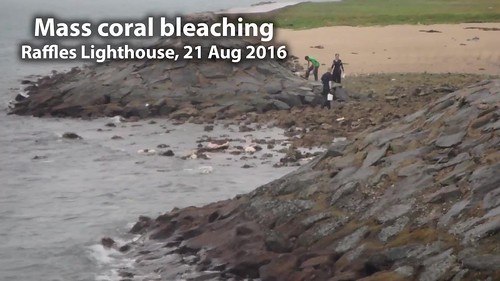 |
| Hard corals may produce slime in reaction to rain (which we had lots of this morning). |
Today, we estimate about 10-30% of hard corals are bleaching, while about 10-20% of leathery soft corals were bleaching. About 20% of the hard corals have died recently. Thanks to Nick for organising the trip as part of his survey of sea anemones and related animals in Singapore.
Here's a video of the mass coral bleaching I saw today.
Mass coral bleaching in Singapore should be ending. From the NOAA's coral reef watch satellite monitoring, Singapore is in the blue Watch zone. It sure is taking a long time for our corals to recover. I hope they can recover before they die. Sigh.
What is coral bleaching?
Coral are colonies of tiny animals called polyps. Each polyp lives inside a little hard skeleton. The huge colony is made up of the skeletons of countless polyps. The polyps of all reef-building hard corals harbour microscopic, single-celled algae (called zooxanthellae). The polyp provides the zooxanthellae with shelter and minerals. The zooxanthellae carry out photosynthesis inside the polyp and share the food produced with the polyp. Corals generally have white colour skeletons, which is believed to assist in photosynthensis by reflecting light onto the zooxanthellae.
 |
| The intertidal shore still thickly covered with a variety of hard and soft corals. Most of them not bleaching. |
 |
| Bleaching corals on the eastern shore of Pulau Satumu. |
A storm hit us just after we started.
 |
| Bleaching subtidal corals on the northern shore. |
 |
| Pulau Biola is just off Pulau Satumu. |
Among the special finds for me was a small Fluted giant clam. The rest of the team saw more giant clams including a Burrowing giant clam.
I thought this was a sea anemone, but it turned out to be a Reef octopus, sheltering in its burrow during the rain.
Kok Sheng saw a Bamboo shark! While Chay Hoon found interesting snails. The rest of the team also had other interesting finds.
Bamboo Shark at Raffles Lighthouse (Pulau Satumu) from Loh Kok Sheng on Vimeo.
Sadly, trash ends up even on remote shores like Raffles Lighthouse.
While Russel shared this photo of a TV among the corals.
We arrived just before sunrise. On the way, we could see the flashing of the lighthouse from a very long distance away. Here's more about the Raffles Lighthouse and other lighthouses in Singapore. During Maritime Week, the Maritime and Port Authority (MPA) usually organises free trips to Raffles Lighthouse for the public. Look out for announcements on the MPA facebook page.
High res photos of mass coral bleaching in Singapore for free download on wildsingapore flickr
Posts by others on this trip
- Russel Low on facebook.
- Marcus Ng on facebook.
On the same day, Lisa Lim and Richard Kuah led the rest of the team on a survey of Pulau Hantu and they also saw mass coral bleaching there. While they did not see many corals bleaching on the intertidal, they did see subtidal corals bleaching. Lisa says: "The corals found in the water around the jetty's area were bleaching and we estimated 30% to 40% of bleaching corals."
Richard says: "Coral bleaching is still on going at certain parts of the island and we estimated 30% of the corals are affected."










